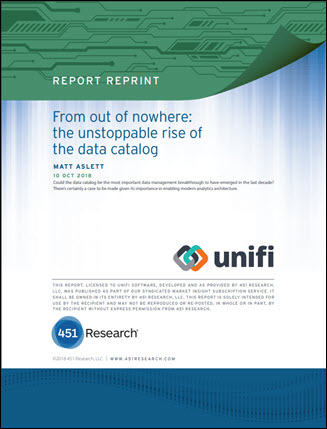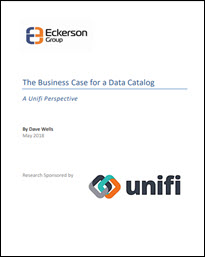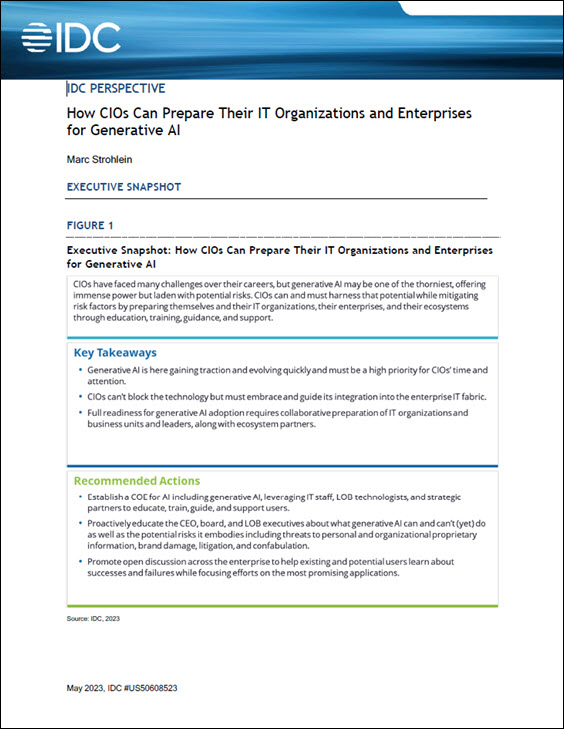Actian, the hybrid data management, analytics and integration company, announced the results of an IT Decision Maker (ITDM) survey. The “Actian Datacast 2019: Hybrid Data Trends Snapshot” polled over 300 IT professionals with key decision-making power in a company of at least 250 employees and asked them what their critical data management pains are.
Actian Survey of IT Decision Makers Reveals Top Data Management Challenges and Industry Shift to Hybrid Data
From Out of Nowhere: the Unstoppable Rise of the Data Catalog
The data catalog has come from nowhere in the past five years to become a key enabling technology for multiple use cases including self-service analytics, self-service data preparation and multi-location data management. Download a new white paper from Unifi Software that explores the data catalog as a major data management breakthrough, as well as its importance in enabling modern analytics architecture.
What Today’s Enterprises Can Learn from Aquaman When it Comes to Data Management
In this contributed article, Philip On, Global Vice President of Product Marketing, Data Management for SAP, discusses the similarities and themes woven throughout popular superhero films that can find grounding in the challenges and opportunities he sees in the business world when it comes to wrangling data in the digital age.
The Data Catalog Business Case
The value and benefits of a data catalog are often described as the ability for analysts to find the data they need quickly and efficiently. Data cataloging accelerates analysis by minimizing the time and effort that analysts spend finding and preparing data.
How Data Management is an Opportunity to Create Business Value?
In this contributed article, Alika Cooper, a Business Development Manager at Cogneesol, discusses the challenges that stem from exponential data growth. To derive maximum business value the need of the hour is to have cohesive data platforms that can bring together data from various sources such as batch analytics and real time ones.
The 2018 State of Data Management
Profisee, a global leading modern data management technology company, released the results of its first annual data management report, “The 2018 State of Data Management.” The survey, conducted between January and April of 2018, aims to provide insights into data management, strategy, challenges, trends, benchmarks and ‘how others are doing it’. It is Profisee’s hope that data management professionals across the global data management community can use this information to help drive new initiatives.
The 2018 State of Data Management
This is the first edition of the Annual State of Data Management Survey from Profisee. It is an interesting time to begin tracking trends in data management. Data management challenges, whether they be around data quality, information processes, duplicate identification, or enrichment, are not new. Profisee believes that every company with more than a handful […]
The Next Generation of Managing Enterprise Data: Cloud Optimized
The inherent elasticity and agility of a cloud-based data platform provides a major operational and financial advantage. This is the final article in a three-part series from Podium. This post focuses on the growing importance of being cloud optimized for managing enterprise data.
The Next Generation of Managing Enterprise Data: Data Conductor
With capabilities to act as what we call a “data conductor”, businesses are free to work with any data at anytime, anywhere to best serve business goals, unlocking the constraints of any data management environment. This sponsored post from Chris Ortega, Senior Director, Customer Success, at Podium Data, is the second in a three-part series focused on the need for increased data agility.
Gen Y, Their Devices and Their Data: How to Manage Data as Millennials Take Over the Workforce
In this contributed article, Kristin McMahon, Senior Director of Product Marketing for Enterprise Information Management (EIM) Solutions at SAP, discusses how enterprises can adapt to the millennial workforce while simultaneously increasing operational productivity, reducing costs, and gaining a competitive advantage. It starts with how to manage data.












